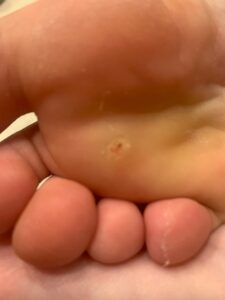Warts
What are warts?
 Warts are caused by a virus which can be spread by skin contact. They are usually harmless to the skin, and will often go away after months or years. Some warts persist or become painful due to the calluses they create. There are many ways to treat warts. Most methods used destroy the skin that the wart virus lives within. These methods can, but rarely, lead to scarring.
Warts are caused by a virus which can be spread by skin contact. They are usually harmless to the skin, and will often go away after months or years. Some warts persist or become painful due to the calluses they create. There are many ways to treat warts. Most methods used destroy the skin that the wart virus lives within. These methods can, but rarely, lead to scarring.
Wart Treatments
We offer multiple options for the treatment of warts.
The most common in-office treatment for warts is Cryotherapy (Freezing). This treatment involves your provider applying liquid nitrogen to the wart. This usually requires multiple treatments.
Book your appointment online or by call or text.
At Home 40% Salicylic Acid Plasters for Treatment of Warts
Supplies:
40% Salicylic Acid Plaster (Mediplast)
Elastoplast tape (waterproof tape)
Callous file or pumice stone
Applying the plaster pad:
1. Cut a piece of the pad approximately the same size as your wart.
2. Peel off the white mesh and discard. Place the pad with the brown sticky surface next to the skin.
3. Generously apply tape over the acid plaster. The treatment will not work if the plaster does not
adhere to the wart.
4. Leave the plaster and tape in place for 2 days.
Removing the pad:
1. When you remove the pad, the area where the plaster has been in contact with the skin will appear white and soft. Fluid may be present. This is the desired reaction. The wart will start peeling off with the dead skin.
2. After removing the plaster pad and tape, gently pare away as much loose white skin as you can with your pumice stone or callous file. It may be easier to pare after bathing.
3. Pare until slightly painful or slightly bleeding, if possible.
Reapplying the pad:
1. Repeat the steps under “applying the plaster pad” and continue treatment until you can see the normal skin markings across the area once occupied by the wart callous. If you see black dots
(tiny blood vessels), you need to continue treatment.
What if it is painful?
If pain occurs, remove the plaster and soak your foot in warm water. Epsom salts may be added to the water. Pain is usually mild and subsides rapidly. It is often associated with friction from shoes or heavy pressure on the wart site from activities and running.
Is infection common?
No, infection is very rare. Signs include:
1. tenderness extending out from the treatment site
2. red streaks up the foot or arm
3. tenderness and warmth at the site
4. thick yellow drainage
If any of these signs are present, please call us at 312-245-9965.



